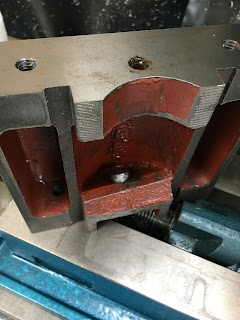Before reassembling the Chinese Kurt clone vise, it seemed rude not to check the rest of the functional parts. Given that the castings were so rough that the machine slide surfaces weren't even skimmed, you'd have to wonder what else they missed.
The "angle lock" feature of these vises is designed to pull down the travelling jaw to prevent it being lifted by work held near the tops of the jaws. As you can see from this Kurt D688 manual / exploded drawing, the travelling nut has a slanted face (60 degrees to vertical) and there is a sort of half ball bearing sitting in a hemispherical socket in the travelling jaw. This is to take up any misalignment of the 2 faces. Ideally they would be perfectly parallel but that's not easy to arrange.
As you might expect, the travelling jaw casting is rougher than a bear's arse and the faces that should be at 60 degrees (and ideally parallel to each other) are miles off. Sure enough there is sort of vaguely spherical hole nearby that was packed with a sort of heavy grease and retained a sort of hemispherical thing. But in fact, a blind man could see that the hole was so far away from where it needed to be that it wasn't even making contact. This is what a Geordie would call "a poond of shite". If you look carefully, you can see a sort of almost-spherical thing sitting where it has a safe view of the action:
Using a bit of Blutak to show me where the contact is being made gave the game away. The "beak" of the nut barely makes it over that ridge, beyond which the spherical indent awaits.
It looks almost as if the vaguely hemispherical ball thing was thrown in for good luck and only the stiffness of the grease had prevented it from coming away. Clearly the nut and travelling jaws were making simple metal-to-metal contact. What a heap of shit.
Bollocks. We have now blundered deep into lipstick-on-the-pig territory. I'll need to be slapping it on with a trowel.
I've ordered some 16mm hardened steel balls from Simplybearings.co.uk I will then use a 16mm ball end mill to create my own socket. Given the challenges of trying to mill a spherical indent in the travelling jaws (lack of access), I'll actually make the indent in the travelling nut and simply mill the face of the mating surface in the travelling jaws flat.
Firstly, machine the face of the travelling nut so that we have a vaguely flat surface for the ball thing to work against:
Then set up the travelling jaw and try to machine the slanted face back to something approaching a flat surface, somewhere close to 60 degrees (although the angle isn't dead critical):
Then set up the travelling nut ready for the ball end mill. No, I'm not planning to use a 16mm drill but it allows me to angle the work just enough for it to clear the holder. It's a bit tight.
Next time - machine the spherical indent and grind one of these 16mm balls down to something approximating a hemisphere.....














No comments:
Post a Comment